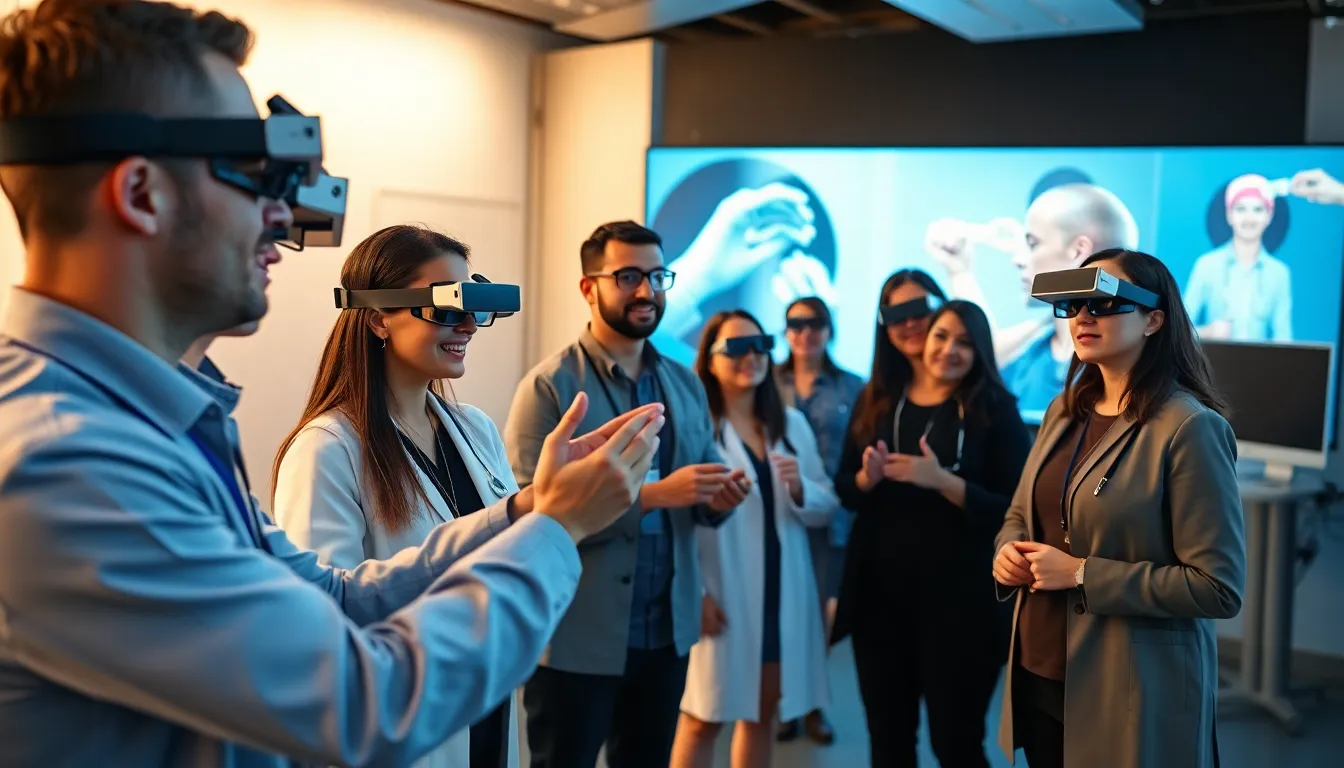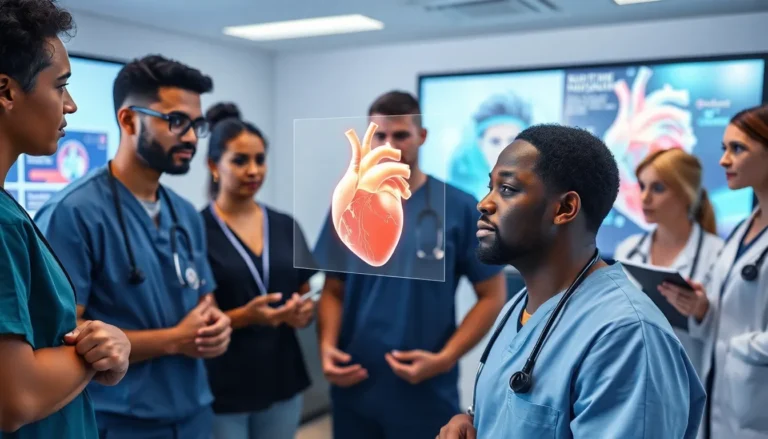Table of Contents
ToggleImagine stepping into a world where your training sessions feel like a video game. Welcome to augmented reality training, where learning meets innovation in the most exciting way. Instead of boring lectures or outdated manuals, this cutting-edge approach overlays digital elements onto the real world, creating an interactive environment that keeps learners engaged and eager to absorb information.
From healthcare professionals practicing surgeries to engineers honing their skills on complex machinery, augmented reality training is revolutionizing how people learn. It’s not just about flashy visuals; it’s about enhancing retention and improving performance. So, if you’re ready to ditch the dull and dive into a training experience that feels more like an adventure, augmented reality might just be the game-changer you’ve been waiting for.
What Is Augmented Reality Training?
Augmented reality training utilizes immersive technology to enhance learning experiences. This method blends digital content with the physical environment, allowing users to interact with both simultaneously. Companies employ augmented reality for skill development, efficiency, and safety training across various industries.
Real-time data overlays are one common feature, providing instant feedback. In healthcare, for instance, medical students practice procedures through virtual simulations. Engineering professionals can visualize complex systems, leading to better understanding and product design.
Gaming elements also play a significant role in this training approach. Learners engage in interactive tasks that enhance retention of information. Augmented reality facilitates a hands-on experience, promoting active participation instead of passive observation.
Another benefit includes adaptability to different learning styles. Visual learners grasp concepts more effectively through augmented visual aids, while kinesthetic learners engage in practical simulations. This versatility makes it a suitable choice for diverse workforce training.
Companies report improvements in employee performance and retention rates. A study showed that organizations using augmented reality for training observed a 70% increase in information retention compared to traditional methods. Engaging with the content leads to better comprehension and application of skills in real-world scenarios.
Overall, augmented reality training represents a significant advancement in educational techniques. By merging real-world tasks with digital tools, organizations enhance training efficacy and create more dynamic learning environments.
Benefits of Augmented Reality Training

Augmented reality training offers various advantages that significantly enhance learning outcomes. Learners experience a richer understanding of concepts through immersive interactions.
Enhanced Learning Experience
Immersion in a blended environment fosters comprehensive comprehension. By integrating digital content with the physical world, augmented reality allows users to visualize complex processes in real-time. Medical professionals practice procedures in a realistic setting, which helps solidify their skills. Simulations ensure learners receive immediate feedback, promoting effective understanding. The technology promotes active learning by encouraging users to engage directly with tasks. With adaptive features, AR training meets the needs of different learning styles, yielding an effective educational approach.
Increased Engagement
Engagement levels rise significantly in augmented reality training programs. Interactive elements captivate learners, transforming mundane tasks into exciting challenges. Gamified experiences encourage participants to explore and experiment, which increases retention. Studies support that augmented reality training leads to a 70% improvement in information retention compared to traditional methods. Users are more likely to participate when the training feels like a game. Employees report finding the learning process enjoyable and memorable, contributing to better performance outcomes in various industries.
Applications in Different Industries
Augmented reality training enhances learning experiences across diverse fields. This method introduces innovative techniques that improve training effectiveness significantly.
Healthcare
In healthcare, augmented reality training supports medical professionals in mastering complex procedures. Medical students use virtual simulations for practicing surgeries and patient interactions. Instant feedback promotes skill refinement and boosts confidence in real-life scenarios. According to research, healthcare training that incorporates augmented reality results in a 30% reduction in training time while increasing knowledge retention by 70%. This technology transforms traditional medical training into an interactive experience, making it easier for healthcare workers to engage with profound concepts and maintain skills.
Manufacturing
Manufacturing industries utilize augmented reality to improve efficiency and safety in training processes. Workers interact with 3D models of machinery, allowing them to visualize assembly and maintenance tasks. This hands-on approach minimizes errors and enhances productivity. Studies show that companies experience a 50% decrease in training costs when implementing augmented reality tools. As a result, employees develop a deeper understanding of equipment and processes, leading to a more proficient workforce. Real-time data overlays assist workers in navigating tasks safely and effectively, creating a smoother integration of new talent.
Education
In education, augmented reality training provides immersive experiences for students at all levels. Learners interact with 3D visualizations of historical events or scientific concepts, enhancing their grasp of complex information. This interactive method caters to various learning styles, captivating both visual and hands-on learners. Research indicates that augmented reality increases student engagement by 85%, making lessons more memorable. Such an innovative approach fosters collaboration among peers, allowing students to explore subjects through teamwork. Educational institutions that adopt augmented reality report improved attendance and overall academic performance.
Challenges of Implementing Augmented Reality Training
Augmented reality training faces several challenges that organizations must address before implementation.
Technical Limitations
Technical limitations often hinder the effectiveness of augmented reality training. Hardware requirements can be substantial, demanding advanced devices to run applications smoothly. Additionally, software compatibility issues arise when integrating AR platforms with existing systems. Users may experience motion sickness or discomfort due to poorly designed AR experiences. Technical support for troubleshooting also requires skilled personnel, adding strain on current resources. Therefore, organizations must invest in robust technology infrastructure to ensure seamless operation.
Cost Considerations
Cost considerations play a crucial role in the adoption of augmented reality training. Initial investments for developing AR content can be significant, especially when creating high-quality simulations. Companies may face ongoing costs for updates and maintenance of AR systems. Training staff to effectively use AR technology further adds to overall expenses. Organizations also need to evaluate the return on investment carefully by measuring improvements in employee performance and training efficiency. Balancing costs with the potential benefits remains a critical challenge for many sectors.
Future of Augmented Reality Training
Augmented reality (AR) training is set to redefine educational frameworks in various sectors. Its increasing popularity highlights potential advancements in immersive learning experiences. Users may expect further integration of AR within corporate environments, especially for skill enhancement and safety protocols. Developers aim to create more user-friendly AR interfaces that require minimal technical expertise.
Healthcare sectors particularly benefit from these developments, showcasing significant improvements in training times and knowledge retention. Early adoption has proven effective, as studies indicate a potential further 30% reduction in training durations with advanced AR applications. Manufacturing industries recognize AR’s role in lowering costs and increasing workforce competency, with projections citing up to a 50% reduction in training expenses.
The educational landscape also stands to gain substantially from AR technology. Student engagement rates may climb even higher as immersive learning becomes the norm, with projections estimating an increase of up to 85% in collaboration and academic performance. Interactivity serves as a catalyst for motivation, pushing learners towards active participation.
While the future looks promising, challenges remain in hardware and software investments. Organizations are exploring more cost-effective AR solutions to mitigate these barriers, allowing widespread adoption among smaller entities. Evaluating return on investment continues to be crucial, with a focus on performance metrics and efficiency gains. As technology evolves, augmented reality training is likely to transform learning into a more interactive and effective endeavor, aligning learning outcomes with organizational goals.
Augmented reality training is revolutionizing how individuals and organizations approach learning. By merging digital content with real-world environments AR training creates immersive experiences that enhance engagement and retention. As industries continue to adopt this innovative method the potential for improved performance and efficiency becomes increasingly apparent.
While challenges exist in terms of technology and cost organizations that invest in AR training stand to gain significant advantages. The future of education and training is likely to be shaped by these immersive technologies fostering a more interactive and effective learning landscape. As AR continues to evolve it promises to redefine skill development across various sectors making training not only more efficient but also more enjoyable.







